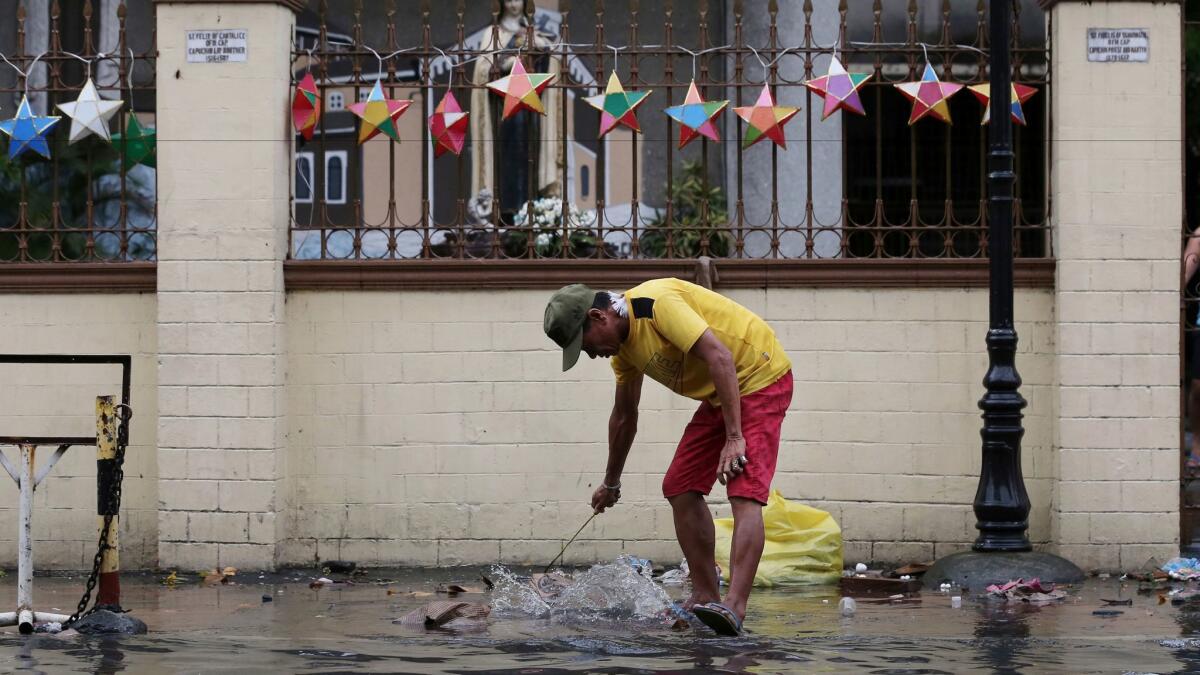Typhoon in the Philippines kills 6, sends hundreds of thousands to emergency shelters on Christmas

A powerful typhoon blew out of the northern Philippines on Monday after killing at least six people and spoiling Christmas in several provinces, where more than 380,000 people abandoned celebrations at home to reach emergency shelters and other safer grounds.
Typhoon Nock-Ten cut power to five provinces due to toppled electric posts and trees, dimming Christmas revelries in Asia’s largest Catholic nation. More than 300 flights were delayed or rescheduled, and ferries were barred from sailing, stranding more than 12,000 holiday travelers.
After the typhoon made landfall in Catanduanes province Sunday night, six people in the provinces of Quezon and Albay, southeast of Manila, died from drowning or by being pinned by fallen trees, poles and a collapsed concrete wall, officials said.
Many military camps and outposts in Catanduanes and outlying provinces were damaged and some troops were injured, the military said.

Nock-Ten, locally known as Nina, then blew westward across mountainous and island provinces, damaging homes, uprooting trees and knocking down communications.
After weakening on landfall, the typhoon had sustained winds of up to 74 mph and gusts of up to 111 mph when it blew into the South China Sea after battering the congested provinces of Batangas and Cavite, south of Manila, government forecasters said.
A cargo ship with about two dozen crew members radioed for help as the vessel started to list off Batangas. It later ran aground and turned on its side near the town of Mabini, the coast guard said.
The storm was one of the strongest to hit the Philippines since Typhoon Haiyan left more than 7,300 people dead or missing and displaced over 5 million in 2014. But officials in some provinces found it difficult to persuade people to abandon their Christmas celebrations and head for the shelters before the storm hit. Some officials said they had to impose forced evacuations.
“Some residents just refused to leave their homes even when I warned them that you can face what amounts to a death penalty,” Cedric Daep, a top disaster-response official in Albay, said by phone.
Shopping malls and stores were ordered to close early on Christmas Day to encourage people to remain indoors, “but at the height of the typhoon, many cars were still being driven around and people were out walking,” Daep said. “We warned them enough, but we just can’t control their mind.”
Officials in Albay, where more than 150,000 villagers were displaced by the typhoon, declared a “state of calamity” on Sunday to allow faster disbursement of emergency funds.
NEWSLETTER: Get the day’s top headlines from Times Editor Davan Maharaj »
About 20 typhoons and storms lash the Philippines each year. In the last 65 years, seven typhoons have struck the country on Christmas Day, according to the government’s weather agency.
Tens of thousands of villagers, forced to spend Christmas in crowded and powerless emergency shelters, started to return home Monday to deal with the damage.
“They have left the evacuation centers and we’re seeing the sun again,” Ann Ongjoco, mayor of the town of Guinobatan in Albay, one of five provinces that lost electricity, said by phone.
But she said her town, where more than 17,600 villagers fled to shelters in schools, will not be able to resume holiday celebrations because of the post-typhoon mess. “Many houses made of light materials were destroyed,” she said.
MORE WORLD NEWS
Netanyahu, furious over U.N. vote on Jewish settlements, summons U.S. ambassador
Russian plane carrying famed chorus crashes into Black Sea; all are believed dead
Why attacks by Boko Haram are likely to continue even though it lost its last stronghold
More to Read
Start your day right
Sign up for Essential California for news, features and recommendations from the L.A. Times and beyond in your inbox six days a week.
You may occasionally receive promotional content from the Los Angeles Times.





